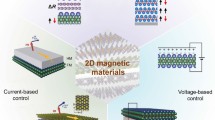Abstract
MAGNETIC materials of mesoscopic dimensions (a few to many thousands of atoms) may exhibit novel and useful properties such as giant magnetostriction, magnetoresistivity and magnetocaloric effects1–4. Such materials also allow one to study the transition from molecular to bulk-like magnetic behaviour. One approach for preparing mesoscopic magnetic materials is to fragment bulk ferromagnets; a more controllable method is to take a 'bottom-up' approach, using chemistry to grow well defined clusters of metal ions5,6. Lis7 has described a twelve-ion manganese cluster in which eight of the Mn ions are in the +3 oxidation state (spin S=2) and four are in the +4 state (S=3/2). These ions are magnetically coupled to give an S=10 ground state8, giving rise to unusual magnetic relaxation properties8,9. Here we report that the magnetization of the Mn12 cluster is highly anisotropic and that the magnetization relaxation time becomes very long below a temperature of 4 K, giving rise to pronounced hysteresis. This behaviour is not, however, strictly analogous to that of a bulk ferromagnet, in which magnetization hysteresis results from the motion of domain walls. In principle, a bistable magnetic unit of this sort could act as a data storage device.
Similar content being viewed by others
References
Gunther, L. Phys. Wld. 3, 28–31 (1990).
Awschalom, D. D., Di Vincenzo, D. P. & Smyth, J. F. Science 258, 414–416 (1992).
Stamp, P. C. E., Chudnosvsky, E. M. & Barbara, B. Int. J. mod. Phys. B6, 1355–1473 (1992).
McMichael, R. D., Shull, R. D., Swartzendruber, L. J., Bennett, L. H. & Watson, R. E. J. magn. Mater. 111, 29–33 (1992).
Papaefthymiou, G. C. Phys. Rev. B46, 10367–10375 (1992).
Kahn, O., Pei, Y. & Journaux, Y. in Inorganic Materials (eds Bruce, D. W. & O'Hare, D.) 59–114 (Wiley, Chichester, 1992).
Lis, T. Acta crystallogr. B36, 2042–2046 (1980).
Caneschi, A. et al. J. Am. chem. Soc. 113, 5873–5874 (1991).
Sessoli, R. et al. J. Am. chem. Soc. 115, 1804–1816 (1993).
Brown, W. F. Jr Phys. Rev. 130, 1677–1686 (1963).
Jacobs, I. S. & Bean, C. P. in Magnetism Vol. 3 (eds Rado, G. T. & Suhl, H.) 271–348 (Academic, New York, 1963).
Author information
Authors and Affiliations
Rights and permissions
About this article
Cite this article
Sessoli, R., Gatteschi, D., Caneschi, A. et al. Magnetic bistability in a metal-ion cluster. Nature 365, 141–143 (1993). https://doi.org/10.1038/365141a0
Received:
Accepted:
Issue Date:
DOI: https://doi.org/10.1038/365141a0
- Springer Nature Limited
This article is cited by
-
Vibronic effects on the quantum tunnelling of magnetisation in Kramers single-molecule magnets
Nature Communications (2024)
-
Giant adiabatic temperature change and its direct measurement of a barocaloric effect in a charge-transfer solid
Nature Communications (2023)
-
Electrical detection and modulation of magnetism in a Dy-based ferroelectric single-molecule magnet
Nature Communications (2023)
-
A hard molecular nanomagnet from confined paramagnetic 3d-4f spins inside a fullerene cage
Nature Communications (2023)
-
Futuristic storage devices: Single molecular magnets of rare earths versus spin crossover systems of earth-abundant metals
Journal of Chemical Sciences (2023)





